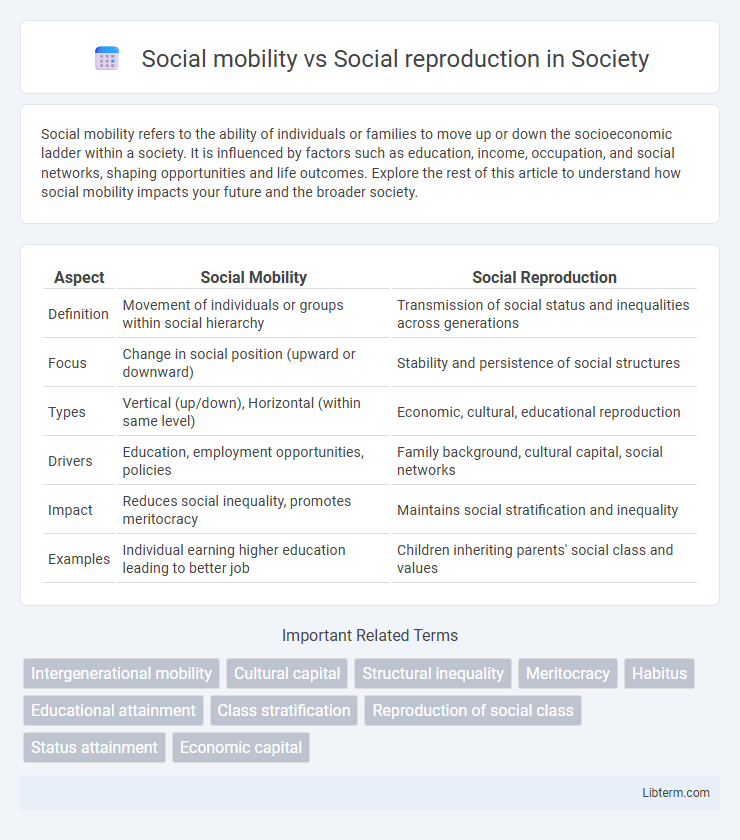Social mobility refers to the ability of individuals or families to move up or down the socioeconomic ladder within a society. It is influenced by factors such as education, income, occupation, and social networks, shaping opportunities and life outcomes. Explore the rest of this article to understand how social mobility impacts your future and the broader society.
Table of Comparison
| Aspect | Social Mobility | Social Reproduction |
|---|---|---|
| Definition | Movement of individuals or groups within social hierarchy | Transmission of social status and inequalities across generations |
| Focus | Change in social position (upward or downward) | Stability and persistence of social structures |
| Types | Vertical (up/down), Horizontal (within same level) | Economic, cultural, educational reproduction |
| Drivers | Education, employment opportunities, policies | Family background, cultural capital, social networks |
| Impact | Reduces social inequality, promotes meritocracy | Maintains social stratification and inequality |
| Examples | Individual earning higher education leading to better job | Children inheriting parents' social class and values |
Understanding Social Mobility
Social mobility refers to the ability of individuals or groups to move within a social hierarchy, often measured by changes in income, education, or occupational status across generations. Understanding social mobility involves analyzing factors such as economic policies, educational access, and social networks that facilitate or hinder upward movement. High social mobility indicates a dynamic society where opportunities for advancement are accessible, while low mobility suggests entrenched social reproduction, where social status is largely inherited.
Defining Social Reproduction
Social reproduction refers to the processes by which societies sustain and perpetuate existing social structures, including class, culture, and inequalities, through mechanisms such as family upbringing, education, and labor markets. It emphasizes how social norms, values, and economic status are transmitted across generations, reinforcing social hierarchies and limiting social mobility. Understanding social reproduction is crucial for analyzing persistent disparities in wealth, education, and opportunity within a given society.
Key Theories Behind Social Mobility
Key theories behind social mobility include structural-functionalism, which views mobility as a mechanism for rewarding talent and ensuring societal efficiency, and conflict theory, which argues that social reproduction perpetuates inequality through control of resources by dominant groups. Human capital theory emphasizes education and skill development as crucial drivers of upward mobility, while cultural capital theory highlights the transmission of values and norms that facilitate social advancement. These frameworks collectively explain how individual efforts interact with systemic factors to shape patterns of social mobility and reproduction.
Mechanisms of Social Reproduction
Mechanisms of social reproduction include family background, educational systems, and cultural capital, which collectively maintain existing social hierarchies across generations. Economic inequality and differential access to resources reinforce social reproduction by limiting opportunities for upward social mobility. Institutional structures, such as residential segregation and labor market segmentation, further perpetuate social status and inhibit transformative social mobility.
Factors Influencing Social Mobility
Economic opportunities, educational access, and social networks significantly influence social mobility by enabling individuals to improve their socioeconomic status across generations. Conversely, social reproduction is reinforced by factors such as family background, cultural capital, and institutional barriers that perpetuate existing class structures. Policies targeting equal education, workforce diversity, and wealth redistribution can mitigate social reproduction and enhance upward mobility.
The Role of Education in Social Mobility and Reproduction
Education serves as a critical mechanism in promoting social mobility by providing individuals with skills and credentials that enhance employment opportunities and economic advancement. However, education systems can also perpetuate social reproduction by reinforcing existing inequalities through unequal access to quality resources, biased curricula, and differential treatment based on socioeconomic status. The dual role of education highlights its capacity to either challenge or sustain social stratification depending on policy interventions and institutional practices.
Economic Inequality and Social Class Persistence
Economic inequality deepens social class persistence by limiting access to resources like education, healthcare, and employment opportunities, which are vital for upward social mobility. Social reproduction occurs when families transmit economic advantages or disadvantages across generations, reinforcing existing class structures. The entrenched wealth gap creates barriers that impede social mobility, perpetuating cycles of poverty and privilege.
Policy Measures Impacting Social Mobility
Policy measures such as increased access to quality education, affordable healthcare, and targeted social welfare programs significantly enhance social mobility by reducing structural barriers. Investments in early childhood development and vocational training improve skills and employment opportunities, thereby disrupting cycles of social reproduction. Progressive taxation and inclusive housing policies also redistribute resources more equitably, supporting upward mobility across disadvantaged populations.
Real-Life Examples: Breaking or Maintaining the Cycle
Social mobility is exemplified by individuals like Oprah Winfrey, who rose from poverty to global influence, demonstrating upward movement in socioeconomic status through education and entrepreneurship. Conversely, social reproduction is evident in families where low educational attainment and limited access to resources perpetuate poverty across generations, as seen in many underserved urban communities. Programs targeting structural barriers, such as scholarships and community development initiatives, aim to disrupt social reproduction and enhance opportunities for social mobility.
Future Prospects for Social Change
Future prospects for social change hinge on enhancing social mobility, which enables individuals to improve their social status through education, employment, and economic opportunities. However, social reproduction often perpetuates existing inequalities by transmitting socioeconomic advantages or disadvantages across generations. Policies aimed at reducing structural barriers and increasing access to resources are crucial for breaking cycles of social reproduction and promoting equitable social mobility.
Social mobility Infographic

 libterm.com
libterm.com